Decorating a small guest room presents a unique challenge: how do you create a comfortable, functional, and stylish haven for visitors within a limited footprint? It’s a common dilemma for many homeowners, where the spare room often becomes a neglected space, serving more as a storage unit than a welcoming retreat. However, with the right strategies, even the most compact room can be transformed into what feels like a boutique hotel experience. This is not about simply painting walls white or buying smaller furniture; it’s about a smarter approach to design.
This guide moves beyond generic advice, offering eight specific, actionable ideas that tackle the core issues of space, light, and functionality head-on. We'll explore how to leverage clever multi-functional furniture, create optical illusions with mirrors and colour palettes, and implement vertical storage to maximise every square inch. Forget the idea that a small space must be sparse or uninviting. We will provide practical implementation details for decorating a small guest room to make it feel expansive, organised, and exceptionally welcoming. Prepare to turn that tiny spare room from an afterthought into a destination your friends and family will genuinely look forward to visiting.
1. Multi-Functional Furniture Selection
In a compact guest room, every square inch is prime real estate. The most effective strategy for decorating a small guest room involves choosing furniture that does more than one job. Multi-functional pieces are the cornerstone of smart, space-saving design, allowing you to provide all the necessary comforts for your guests without overwhelming the limited space. This approach prioritises utility and efficiency, ensuring the room remains uncluttered and functional.
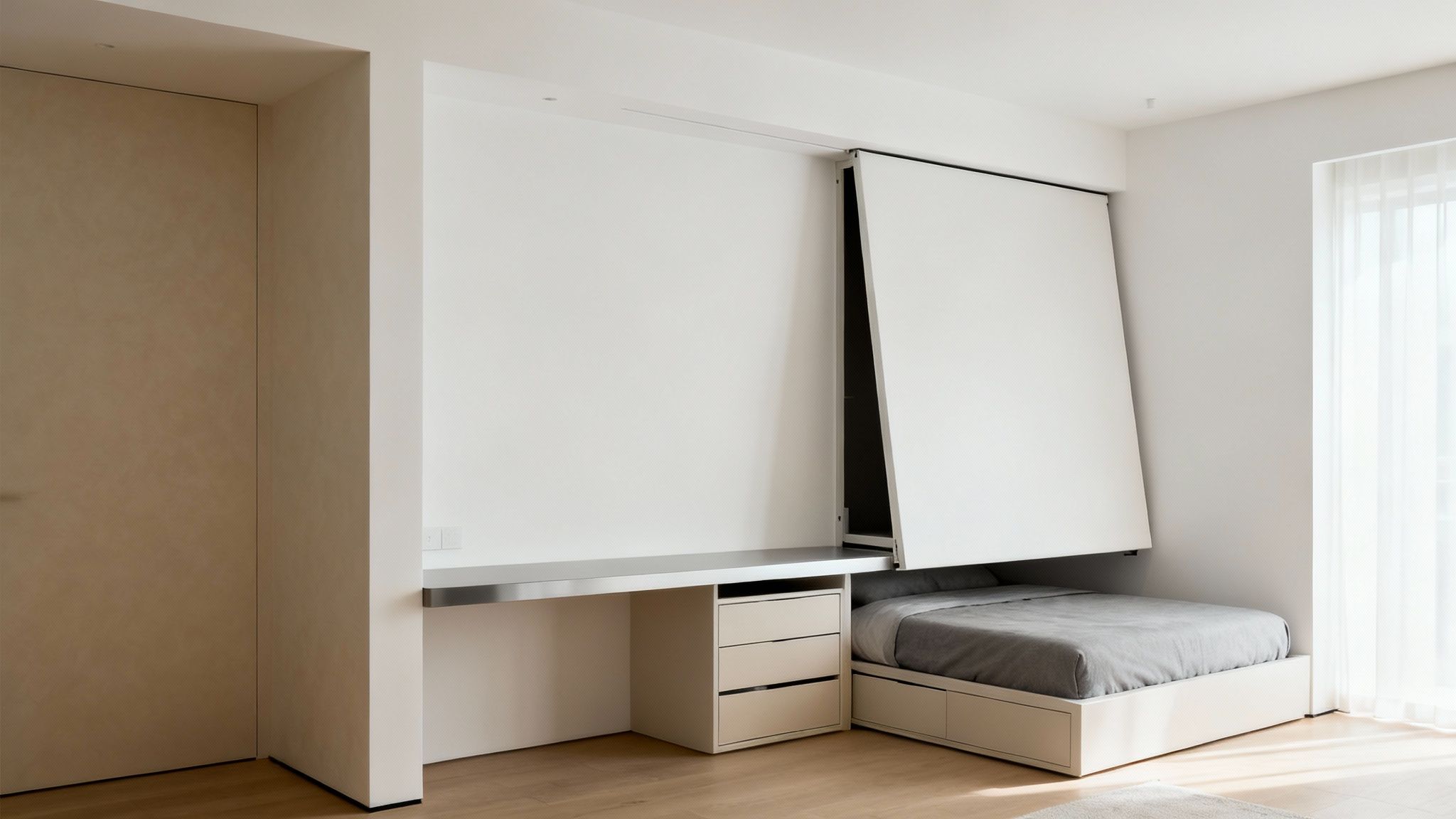
The goal is to minimise the furniture's physical footprint while maximising its usefulness. Think of a daybed with built-in drawers that provides seating during the day, a comfortable bed at night, and storage for spare linens. Similarly, a stylish ottoman can serve as a footrest, extra seating, and a hidden storage container for blankets or towels. For the ultimate space-saver, a Murphy bed folds seamlessly into a wall unit, often revealing a desk or shelving.
How to Implement This Strategy
To successfully integrate multi-functional furniture, focus on the primary needs of a guest. A comfortable place to sleep, storage for their belongings, and a surface for personal items are essential.
- For Sleeping & Seating: A sofa bed or a daybed like IKEA's Hemnes model combines these functions perfectly. For extremely tight spaces, a convertible sleeper chair from a brand like CB2 offers a compact solution.
- For Storage & Surfaces: Opt for a storage bench at the foot of the bed, providing both seating and a place to store extra bedding. A lift-top ottoman can function as a coffee table and storage unit, while a slim nightstand that doubles as a small desk offers a spot for a laptop.
- Invest in Quality: When choosing pieces with moving parts, such as wall beds pioneered by brands like Resource Furniture and Clei, investing in high-quality mechanisms is crucial for longevity and ease of use. Your guests should be able to transform the furniture without difficulty.
Key Insight: Before purchasing, meticulously measure your room. Ensure there is enough clearance to open doors, pull out drawers, and convert furniture without it hitting walls or other items.
This clever use of furniture is fundamental to creating a welcoming and practical guest room. For a deeper dive into making the most of limited areas, you can explore more small space decorating ideas for additional inspiration.
2. Light and Neutral Colour Palettes
Using light, neutral colours on walls, ceilings, and larger furniture pieces is a fundamental strategy for making a small guest room feel more spacious and airy. This decorating approach leverages the optical effects of colour to create the illusion of expanded space. Whites, soft greys, beiges, and pale pastels reflect more light, making rooms appear larger and more welcoming. This doesn't mean the room has to be plain; texture and subtle patterns can add personality while maintaining the expansive feel.
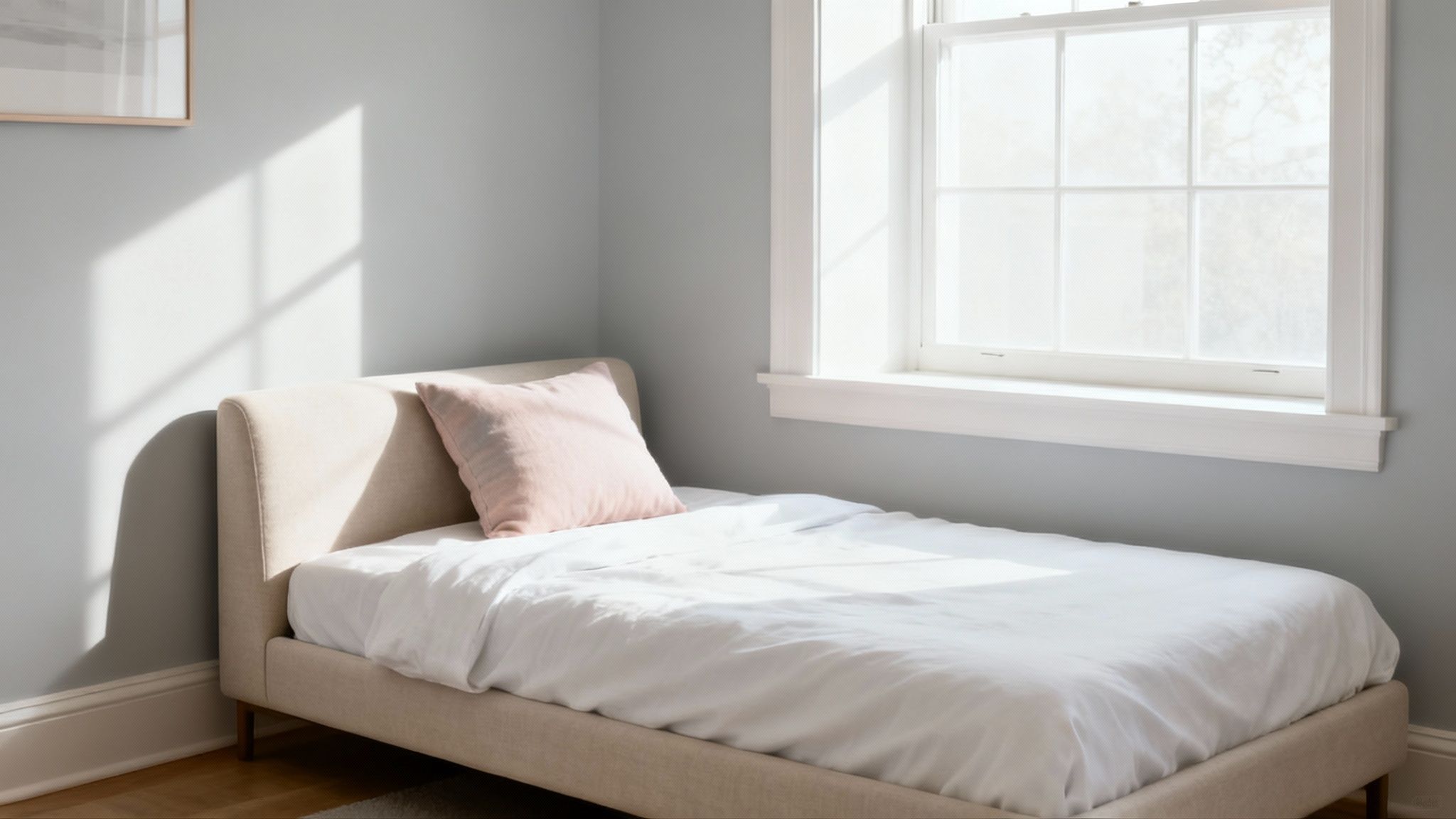
The core idea is to create a bright, seamless backdrop that tricks the eye into perceiving more depth. This aesthetic, popularised by designers like Joanna Gaines and the minimalist Scandinavian design movement, is consistently used to enhance compact living areas. Paint brands like Farrow & Ball and Benjamin Moore offer sophisticated neutral collections specifically for this purpose, with shades like 'Simply White' becoming a go-to for small room transformations.
How to Implement This Strategy
To successfully use a neutral palette, focus on layering tones and textures to add depth and warmth, preventing the space from feeling sterile or one-dimensional. The right shade can make all the difference in a compact room.
- Choose Warmth: Opt for warm whites with yellow or pink undertones over cool whites with blue undertones. This creates a more inviting and cosy atmosphere for your guests.
- Layer Tones: Decorate with multiple shades from the same neutral family. For example, pair beige walls with cream-coloured bedding and off-white curtains to build visual interest without overwhelming the space.
- Add Natural Textures: Incorporate materials like linen, jute, light-toned wood, and wool. A jute rug or a wooden side table can introduce warmth and prevent a neutral room from feeling cold.
- Utilise Paint Finish: Use a satin or semi-gloss finish on trim and doors. These finishes reflect more light than a matte wall paint, helping to bounce light around the room and create a brighter feel.
Key Insight: Before committing to a paint colour, test it directly on the walls. Observe how it looks at different times of the day, as natural and artificial light can dramatically alter its appearance in a small space.
This strategic use of colour is a powerful tool for decorating a small guest room. To gain more confidence in your choices, you can explore detailed advice on how to choose paint colours for any room in your home.
3. Strategic Mirror Placement
When decorating a small guest room, mirrors are an indispensable tool for creating the illusion of a larger, brighter space. They work by reflecting light and the room itself, effectively doubling the visual area and illuminating darker corners. Strategic placement is key; a well-positioned mirror can completely transform the feel of a compact room, making it feel more open, airy, and inviting for your guests. Beyond their space-enhancing function, mirrors also act as stylish decorative pieces that can define and elevate the room's aesthetic.
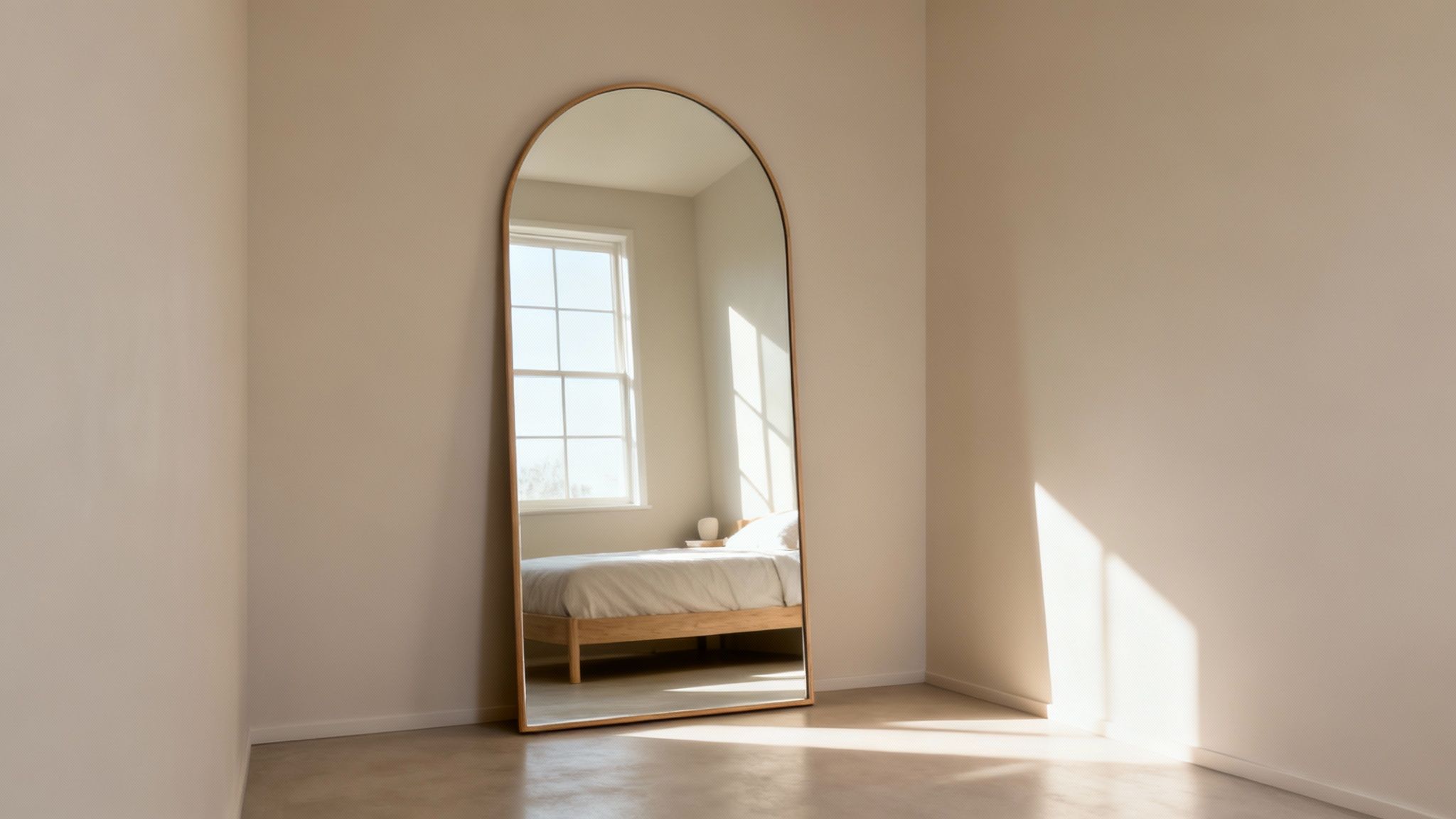
The trick is to position mirrors to maximise their impact without creating awkward reflections or overwhelming the space. Consider a large, full-length leaner mirror, popularised by brands like Restoration Hardware, placed opposite a window. This will capture and bounce the maximum amount of natural light around the room. Similarly, placing a decorative mirror like Anthropologie's iconic Primrose Mirror above a dresser creates a beautiful focal point while amplifying the room’s perceived depth. Even floor-to-ceiling mirrored wardrobe doors, a staple in high-end hotel design, can make a tiny room feel grand.
How to Implement This Strategy
To use mirrors effectively, consider both the light sources and the overall layout of the guest room. The goal is to enhance brightness and the sense of space while complementing your décor.
- Maximise Natural Light: Position a large mirror directly opposite the main window. This simple technique reflects the outside view and floods the room with light, making it feel instantly bigger.
- Create a Focal Point: Hang a beautifully framed mirror above a key piece of furniture, such as the bed's headboard or a small console table. West Elm’s popular Arched Mirrors are perfect for this, adding a touch of modern elegance.
- Brighten Dark Corners: Place a mirror on a wall perpendicular to a window or in a poorly lit corner to help distribute light more evenly throughout the space.
- Consider Mirrored Furniture: For a more subtle approach, incorporate mirrored nightstands or a mirrored chest of drawers. These pieces provide reflective surfaces without dominating a wall.
Key Insight: Always consider what the mirror will reflect. Avoid placing it where it will show a cluttered area, an unmade bed, or directly reflect the doorway, which can be unsettling for guests.
The strategic use of mirrors is a classic designer trick, popularised by icons like Dorothy Draper, for a reason: it's one of the most effective ways to make any small guest room feel more spacious and luxurious.
4. Vertical Storage Solutions
When decorating a small guest room, floor space is a luxury you can't afford to waste. Thinking vertically is a transformative strategy that utilises the often-overlooked wall space from floor to ceiling for storage and display. This approach involves implementing tall bookcases, wall-mounted shelving, and narrow dressers to draw the eye upwards, creating the illusion of a more spacious and airy room.

The core principle is to maximise storage capacity without encroaching on the room's limited footprint. This method, popularised by organisation experts and the tiny house movement, shifts storage from bulky, horizontal units to sleek, vertical solutions. A floor-to-ceiling shelving unit, for instance, offers a place for guests to store their belongings, display decorative items, and even house a few books or magazines for their stay.
How to Implement This Strategy
To successfully add vertical storage, the goal is to balance function with aesthetics, ensuring the solutions enhance the room rather than clutter it. Start by identifying an underused wall and consider the specific needs of your guests.
- Install Wall Shelving: Floating shelves are a fantastic option as they provide storage without any visual weight. Install them in columns or staggered patterns to create a feature wall. Slim, ladder-style bookcases like CB2's Stairway model offer a modern, open feel perfect for a compact space.
- Go Tall, Not Wide: Choose a tall, narrow chest of drawers instead of a wide, low dresser. This provides the same amount of storage while occupying a fraction of the floor space. Similarly, a tall bookcase like IKEA's classic BILLY can be extended to the ceiling for a custom, built-in look.
- Organise Open Shelves: To maintain a tidy appearance, use matching baskets or decorative boxes on open shelves. This conceals clutter and creates a cohesive, organised aesthetic. Place essential items at an accessible height and store less-used items on the higher shelves.
Key Insight: For a seamless and sophisticated look, paint your vertical shelving units the same colour as the walls. This technique helps the furniture blend in, making the room feel larger and less cluttered.
By taking advantage of your room's height, you can provide ample storage and create a stylish, functional guest room that feels far more generous than its dimensions suggest. To explore more built-in options, consider these clever storage ideas to build in while you renovate for inspiration.
5. Minimalist Approach and Decluttering
Embracing minimalism when decorating a small guest room means being intentional about every item in the space. This decorating philosophy, popularised by figures like Marie Kondo and brands such as Muji, is particularly effective in compact areas because it creates a sense of calm, order, and spaciousness. It prioritises keeping only what serves a genuine functional or aesthetic purpose, eliminating both visual and physical clutter.
The minimalist approach is not about creating a stark or cold environment. Instead, it emphasises quality over quantity, with each carefully chosen piece making a meaningful contribution to the room's comfort and style. For a guest room, this translates to providing all the essential comforts without overwhelming visitors with unnecessary objects, a principle seen in the thoughtful design of Japanese ryokan guest rooms and high-rated Airbnb Plus properties.
How to Implement This Strategy
To successfully apply minimalism, focus on providing a serene and functional retreat for your guests. The goal is a clean, organised space where they can relax and easily find what they need.
- Edit Your Inventory: For every item in the room, ask if it serves an essential function or genuinely enhances the aesthetic. Follow the 'one in, one out' rule to maintain balance when adding new decor.
- Curate Wall Decor: Instead of a busy gallery wall, which can make a small room feel crowded, limit wall art to one to three meaningful pieces. This creates a focal point without adding visual noise.
- Conceal Supplies: Keep extra towels, toiletries, and other guest supplies neatly stored away in closed cabinets, sleek baskets, or under-bed storage. This keeps surfaces clear and maintains a tidy appearance.
- Provide Breathing Room: Ensure you leave empty drawer and closet space for your guests to unpack and feel at home. A clear bedside table with just a lamp and perhaps a single book is far more welcoming than a cluttered one.
Key Insight: A limited colour palette of two to three main colours reinforces a minimalist aesthetic. This creates a cohesive and calming atmosphere that makes a small space feel larger and more restful.
By decluttering and choosing each element with care, you can transform a compact room into a tranquil, hotel-like sanctuary. For those looking to master the art of curated living, exploring resources like The Minimalists can provide further guidance.
6. Lighting Layering Strategy
Effective lighting can dramatically transform a small guest room, making it feel larger, more inviting, and significantly more functional. A strategic approach to lighting involves layering different sources to create depth and ambiance. This technique, a standard in professional interior design, moves beyond a single overhead fixture to combine ambient, task, and accent lighting, ensuring every corner of the room is well-lit and welcoming. Proper lighting is a powerful tool in decorating a small guest room, as it eliminates shadows that can make a space feel cramped.
The goal is to provide a balanced and versatile lighting scheme that caters to various needs, from general illumination to focused reading. Ambient lighting provides the room's overall glow, typically from a ceiling fixture or recessed lights. Task lighting is directed at specific activities, such as reading in bed, and is often provided by bedside lamps or wall sconces. Accent lighting draws attention to features like artwork or architectural details, adding a layer of visual interest. Together, these layers create a dynamic and comfortable environment.
How to Implement This Strategy
To layer lighting successfully, think about the different activities a guest will undertake in the room. This will help you place lights where they are most needed, creating a practical and aesthetically pleasing setup.
- For Ambience: Start with a central ceiling light or recessed downlights fitted with a dimmer switch. This provides general, adjustable illumination. Brands like Lutron are leaders in dimmer technology.
- For Tasks: Free up precious surface space by using wall-mounted lighting. Boutique hotels like Ace and CitizenM use stylish swing-arm lamps beside the bed, while Restoration Hardware's library sconces offer a classic solution for reading.
- For Accent: Create a soft, inviting glow by placing LED strips, like those from Philips Hue, behind the headboard or along shelving. This technique washes the walls with light, making the room feel more expansive.
Key Insight: Always install dimmer switches on your main light sources. This single feature provides ultimate control, allowing guests to adjust the brightness from a soft nightlight to a bright, energetic level to suit their mood and needs.
This layered approach ensures the room is both beautiful and functional. For more inspiration on creating the perfect atmosphere, you can discover more lighting ideas for your home and apply them to your guest space.
7. Smart Use of Textiles and Textures
Incorporating varied textiles and textures is a professional decorating secret for adding warmth, depth, and visual interest to a small guest room without occupying any physical space. This technique involves layering different fabrics through bedding, curtains, rugs, and throw pillows to create a sophisticated, welcoming environment. In a compact room, particularly one with a neutral colour scheme, texture becomes the primary tool for adding dimension and preventing the space from feeling flat or sterile.
The strategy is to engage the senses, making the room feel more luxurious and thoughtfully designed. A chunky knit throw draped over a smooth linen duvet, or a plush velvet cushion against a crisp cotton pillowcase, creates a tactile experience that adds character. Strategic textile choices also significantly improve acoustics and temperature regulation, which are critical factors in creating a comfortable stay for any guest.
How to Implement This Strategy
To master the art of texture in your decorating, focus on creating layers and contrast. The goal is to make the room feel curated and cosy, not chaotic.
- Layer the Bedding: This is the room's centrepiece. Start with crisp cotton or breathable linen sheets, add a waffle-weave blanket or a textured coverlet, and top it with a smooth duvet. Finish with a chunky knit or faux-fur throw. Brands like Parachute Home have popularised this layered, neutral-toned linen look.
- Mix Materials: Aim to include at least three distinct textures. Combine smooth surfaces (like cotton), soft materials (like velvet or chenille), and nubby or coarse textures (like wool, jute, or boucle).
- Control Colour and Pattern: To avoid overwhelming the small space, mix textures within the same colour family. If you introduce patterns, as seen in the eclectic Jungalow style, limit them to one or two key elements, like a statement cushion or a rug, keeping the rest of the textiles solid.
Key Insight: When decorating a small guest room, prioritise natural fibres like cotton, linen, and wool for bedding. They are more breathable and regulate temperature better than synthetic alternatives, ensuring your guests have a more comfortable night's sleep.
8. Creating Zones for Functionality
Dividing a small guest room into distinct functional zones makes the space feel more organised and purposeful, despite its compact size. This decorating strategy involves designating specific areas for sleeping, working or reading, and dressing, even when these zones overlap spatially. This concept, popularised by IKEA’s efficient room layouts and Japanese design principles, helps guests mentally organise the space and understand how to use it effectively, making the room feel more substantial.
The goal is to create visual separation without erecting physical walls. For instance, a well-placed area rug can define the sleeping area, while a slim desk positioned against one wall creates a dedicated workspace. This approach is particularly crucial when the guest room must also function as a home office. By carving out specific 'zones', you provide clarity and order, transforming a single-use room into a multi-functional, comfortable retreat for your visitors.
How to Implement This Strategy
To successfully zone your guest room, consider the primary activities that will take place there. Sleeping, dressing, and perhaps working are the most common. Use furniture, lighting, and textiles to subtly delineate these spaces.
- Define with Rugs & Furniture: Use an area rug to anchor the bed and create a distinct sleeping zone, even on a carpeted floor. A low bookshelf can act as a divider between the bed and a small seating area, offering both separation and storage. If you're interested in using shelving this way, you can discover more tips on how to style bookshelves for maximum impact.
- Use Strategic Lighting: Install different types of lighting for each zone. A soft, warm lamp on the bedside table is perfect for the sleeping area, while a brighter, focused task light is ideal for a desk or reading nook.
- Create a Dressing Nook: Designate a corner near the wardrobe as a dressing zone. A full-length mirror, a small stool or bench, and a valet stand can create a practical and thoughtful area for guests to get ready.
Key Insight: Maintain clear pathways of at least 30-36 inches between zones. This ensures the room feels open and easy to navigate, preventing a cramped or cluttered atmosphere despite the multiple functions.
8 Key Strategies Comparison for Small Guest Room Decorating
Your Blueprint for a Brilliant Small Guest Room
Decorating a small guest room isn’t about navigating limitations; it's about unlocking potential. Throughout this guide, we've explored eight powerful strategies designed to transform even the most compact space into a welcoming and functional retreat. The journey from a cramped, overlooked room to a cherished guest haven is paved with intentional choices and clever design. By now, you should feel equipped with a comprehensive toolkit for tackling this rewarding project.
Let's recap the core principles that form your blueprint. We started with the foundation: multi-functional furniture that works harder, providing comfort and storage without consuming precious floor space. We then illuminated the room with light, neutral colour palettes and amplified that brightness with strategic mirror placement, creating an illusion of depth and openness that defies the room's actual dimensions. These visual tricks are fundamental to making a small room feel grander than it is.
From Clutter to Cohesion
Beyond the basics, we delved into the organisational and atmospheric elements that truly elevate a space. Embracing vertical storage draws the eye upward, while a commitment to a minimalist, decluttered approach ensures every item has a purpose, contributing to a sense of calm. The magic of a well-designed space is often in the details, which is why a sophisticated lighting layering strategy is so crucial. It allows you to tailor the mood for any occasion, from a bright reading nook to a soft, relaxing evening ambiance. Finally, we tied it all together with the tactile comfort of well-chosen textiles and the logical flow of functional zones, proving that thoughtful decorating a small guest room is the ultimate act of hospitality.
Your Next Steps to a Perfect Guest Space
The real transformation begins now. Don't feel you must implement every idea at once. Instead, start with the one or two strategies that resonate most with your space and your guests' needs.
- Assess and Prioritise: Walk into your guest room with fresh eyes. Is the most significant issue a lack of storage, poor lighting, or a generally cluttered feeling? Identify the primary challenge and select the corresponding strategy from our list to tackle first.
- Create a Mood Board: Gather inspiration. Save images of small rooms you admire, collect fabric swatches, and pick out paint samples. This visual plan will keep your design cohesive and focused.
- Measure and Map: Before purchasing a new daybed or shelving unit, measure your space carefully. Use masking tape on the floor to map out furniture placement to ensure a comfortable flow.
Ultimately, mastering the art of decorating a small guest room is a powerful demonstration of thoughtful design and warm hospitality. It shows your visitors that their comfort is a priority and proves that style and function are not dictated by square footage. You have the blueprint; now it's time to build a beautiful, brilliant space that makes every guest feel truly at home.

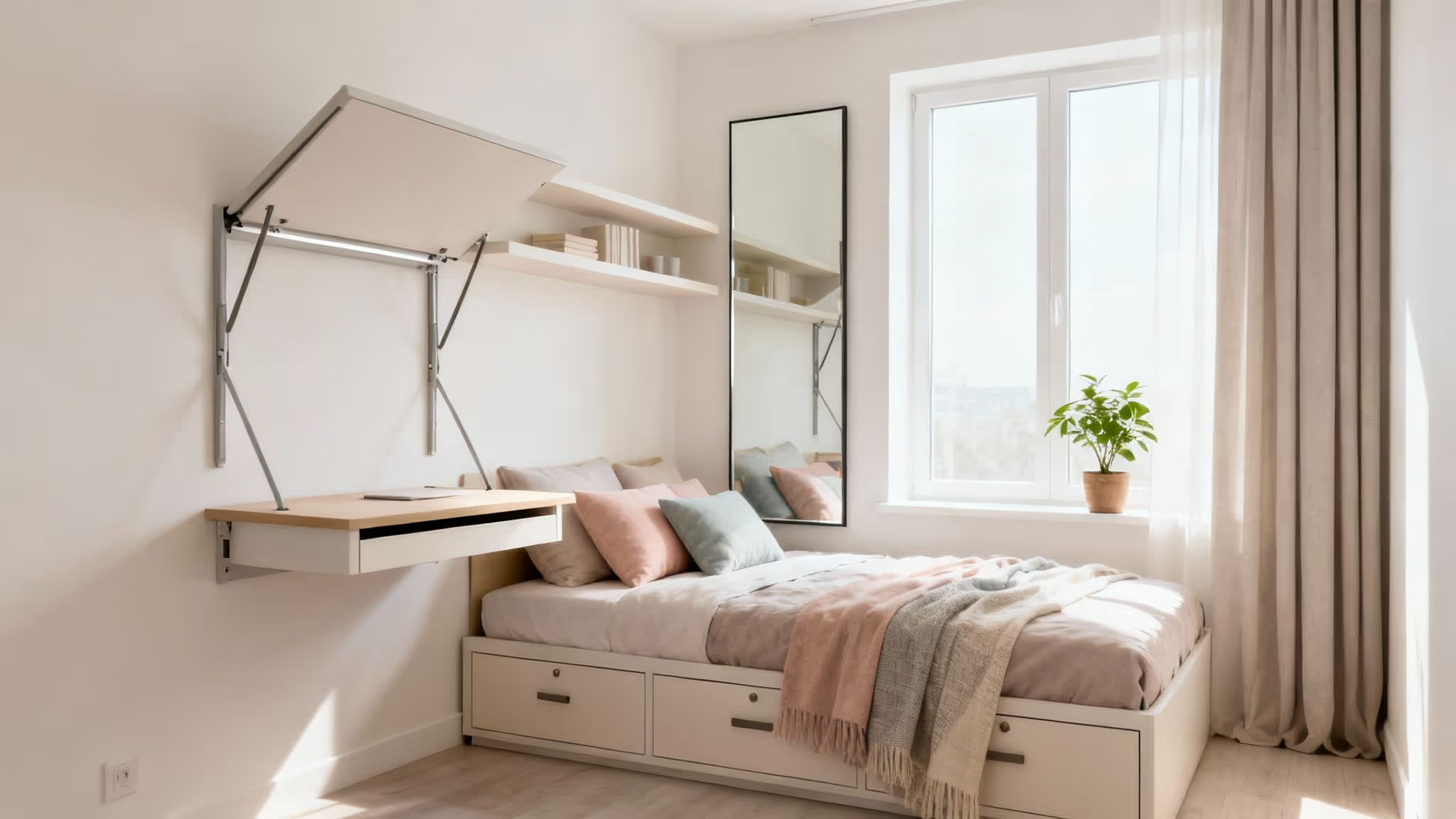
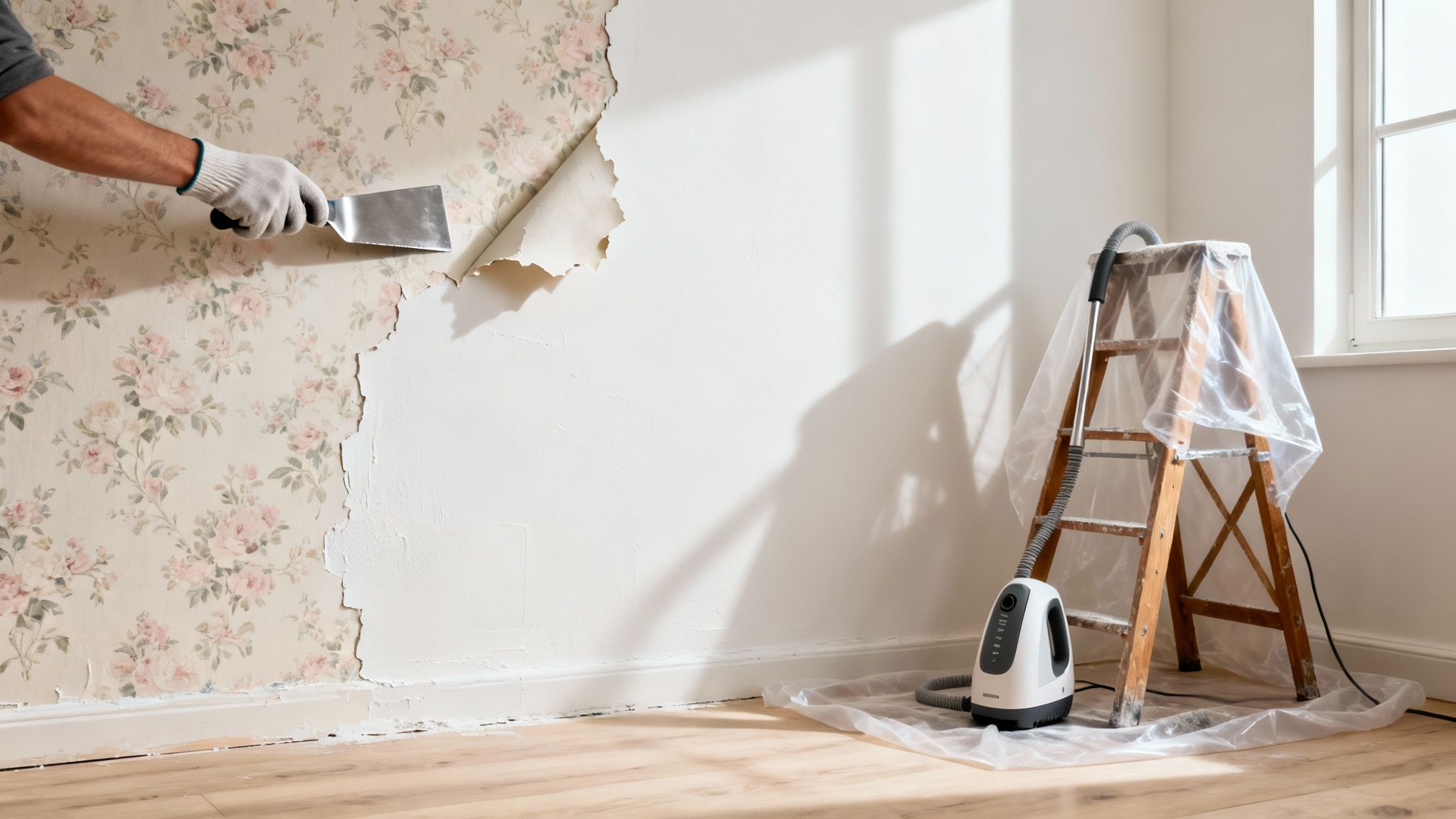
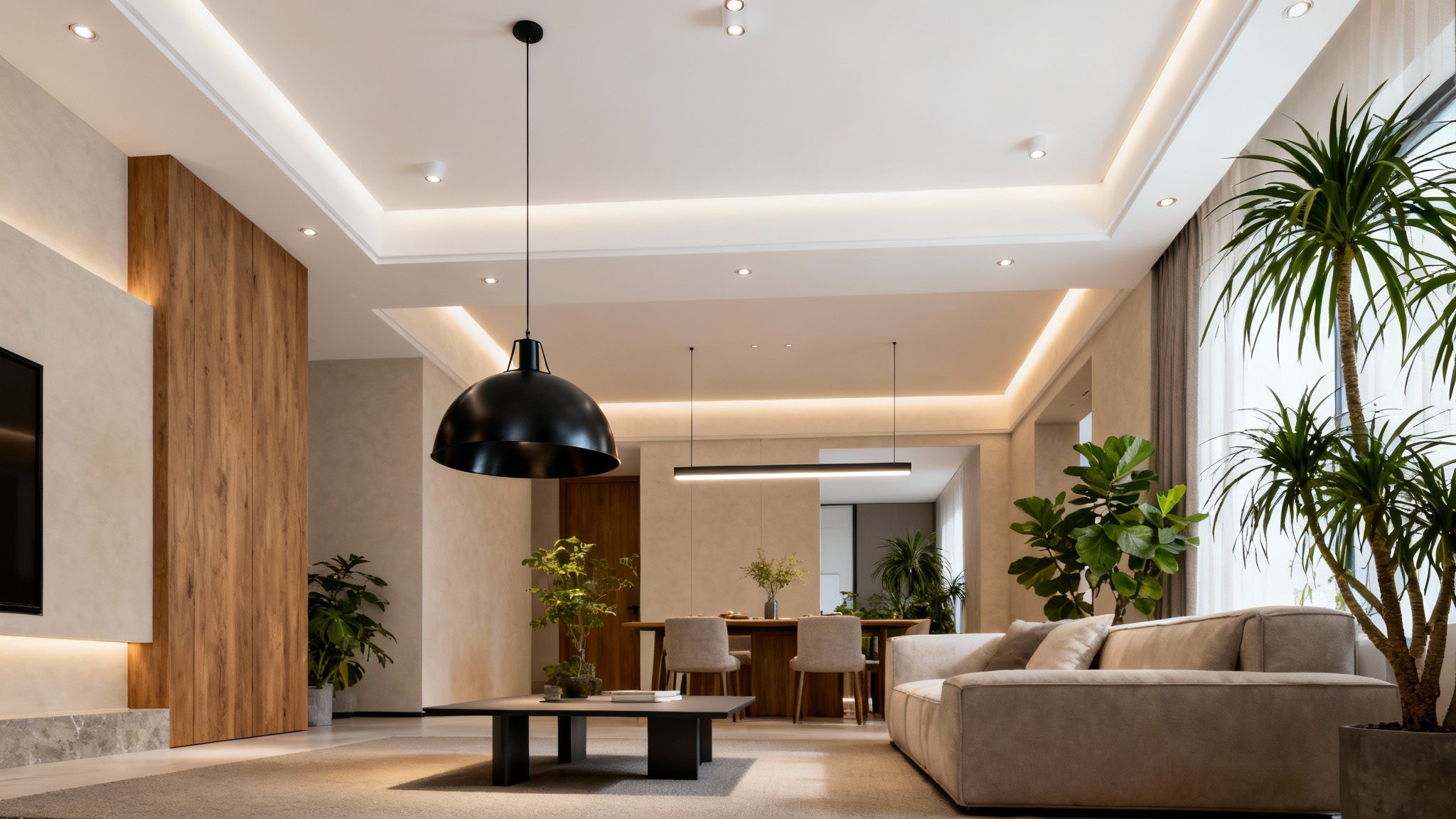
.jpeg)